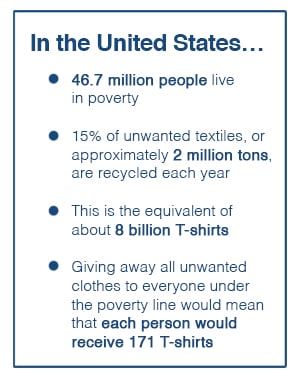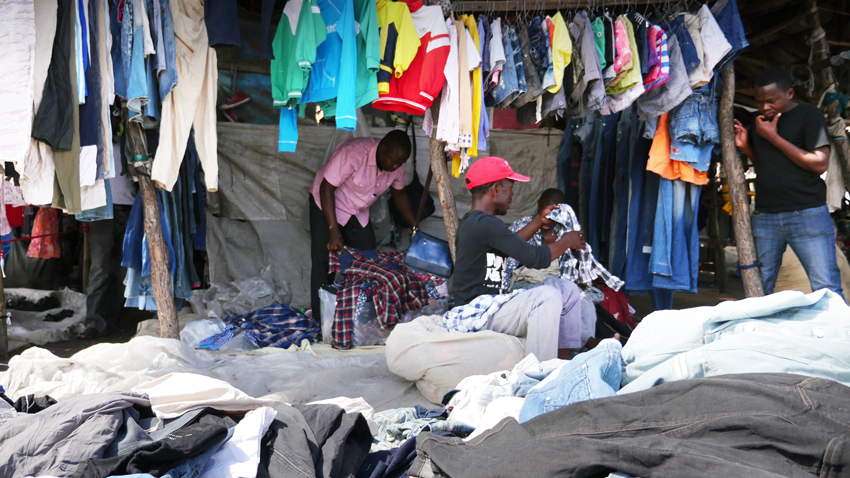Exceeding the Demand: Why America's Secondhand Clothing Doesn't Always Stay Local
When our closets begin to overflow, we need a solution. The most common one is the trash bin, where 85 percent of all clothing in the United States ultimately ends up. The remaining 15 percent is recycled, usually by being passed along to a nonprofit organization.
Given the U.S.'s reputation for charitable giving, it makes sense that Americans want to do something positive with their old clothing. Not everyone knows exactly what kind of impact their donation is making, however. Clothes and shoes are often donated with the belief that they will go to the less fortunate in local communities. While this is true in some cases, the majority of donated items are exported. It is estimated that charitable thrift stores only sell about 20 percent of the donations they receive locally, with the rest being sold overseas, primarily in developing countries.
This practice is actually a productive and mutually beneficial way to handle the massive amount of textiles that the United States consumes. Used clothes are shipped to places where the demand for secondhand goods is high (the United States alone exports about $797 million worth of used textiles in one year, more than any other country). Local entrepreneurs sell and repair these items to make a living. The charities that originally collected the clothes use the funds from the sale to support their philanthropic programs. The millions of garments that would otherwise be decomposing in a landfill are given a second life.
Supply Swamps Demand
This process has caused confusion due to the skewed perception of the actual demand for used apparel in our country. In reality, the U.S. has more unwanted clothing than anyone here could ever use. Fashion is more affordable than ever, which means we are buying and discarding at a faster rate than ever. It's not unusual to be able to find fashionable, brand new items for less than $10. On average, less than 3 percent of annual household income is spent on clothing. There are lots of ways in which we can assist people living under the poverty line, but providing clothing is not the most pressing need.
 Even if we wanted to give away all donated clothing to beneficiaries in the United States, we couldn't begin to distribute the massive amount that we have. The homeless population, for example, averages around 600,000 individuals on any given night nationwide. Planet Aid alone collects 100 million pounds of textiles in one year. If we distributed our total annual collection to 600,000 homeless individuals, they would each receive 166 pounds of clothing, which equates to more than 300 T-shirts per person.
Even if we wanted to give away all donated clothing to beneficiaries in the United States, we couldn't begin to distribute the massive amount that we have. The homeless population, for example, averages around 600,000 individuals on any given night nationwide. Planet Aid alone collects 100 million pounds of textiles in one year. If we distributed our total annual collection to 600,000 homeless individuals, they would each receive 166 pounds of clothing, which equates to more than 300 T-shirts per person.
Overestimating this need can be harmful, too. When disaster hits, clothing is one of the most donated items, but also one of the least needed. Clothes are a low priority item for families in crisis, and aid organizations are forced to handle this influx of superfluous items. An article by Charity Navigator stresses that sending physical supplies like clothing is an impractical way of giving during a crisis, and instead suggests selling clothing in a garage sale and then donating the proceeds to an organization already helping. A spokesperson for the Center for International Disaster Information agrees, arguing that "shipping clothing is not nearly as efficient or even convenient as making a cash donation because clothing is almost universally available."
Making a Difference with Your Secondhand Donations
Selling secondhand clothing in developing countries is one of the best ways to maximize the beneficial impact of your old clothes. If the immense amount of textiles that high-income countries exported each year was to be distributed free of charge in these places, then both informal secondhand and formal textile industries would be severely disrupted. Instead of providing a singular handout, the secondhand clothing industry provides jobs in trading, distributing, repairing, restyling, and washing clothes. Secondhand items are more affordable for local families, and have a smaller environmental footprint than similarly inexpensive new goods from China.
And in the end, this process still supports local charities by providing a supplementary source of funding for their mission. You can seek out an organization that champions a cause close to your heart knowing that the money earned is being put to good use. Planet Aid will accept any of your unwanted textiles—the good, the bad, and the ugly—and use the funds to support sustainable projects like teacher training, Farmers' Clubs, and Child Aid in Africa, Asia, and the Americas.
Learn more about secondhand clothing:
5 Reasons to Recycle Your Clothes
Think We Shouldn't Support International Development? Think Again.
Why Sell Used Clothing?
5 Myths About Used Clothing

